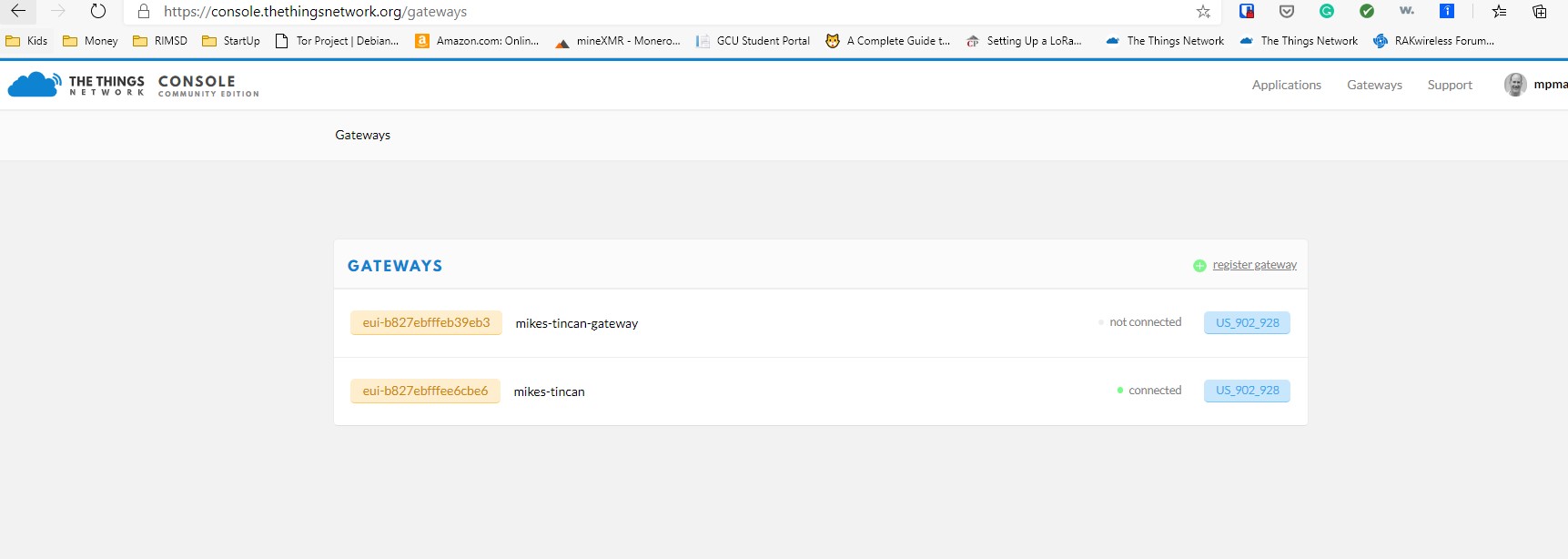Kids? Significant other? Grandma? Maybe they are all next door laughing their a55 off?
Not really, except for Determine which gateway is used by a given node - #12 by arjanvanb. And the forum’s bookmarking functionality helps, but I’ve started using that too late. So it’s mainly search for keywords I remember…
@arjanvanb @descartes This device seems to have fallen over since I powered down my device. I would say the evidence is starting to mount. My gateway is going by an alias. Its some sort of undercover rogue agent.
https://www.thethingsnetwork.org/gateway-data/gateway/eui-b827ebfffee6cbe6
Whilst it fills me with a random range of uncomfortableness but given that the EUI is generated from the Pi’s MAC address so isn’t a “real” one and if you change Pi, it won’t change in the config, let’s try changing your EUI on the device to the one that TTN thinks you have.
Or, if you have the patience, re-install the whole gateway just in case you have multiple Pi’s and we have some re-generation of the EUI issue going on.
…which it probably has multiple? Like WiFi and ethernet?
Can you actually still register the 6cbe6 one? Probably not, given it has a description from somewhere.)
@descartes @arjanvanb I powered the device back on. Then I updated the global configuration and restarted the packet forwarder. I noticed the device started updating again. I then went to register a gateway with b827ebfffee6cbe6 as the EUI and this time it accepted it without issue. The gateway is now showing up in the console with EUI of b827ebfffee6cbe6 and it shows as connected. I also still have the old not connected gateway too. I figure I will just leave that one in case it somehow one day magically reverts to that value. I believe I do have both Ethernet and WiFi configured on that pi. I didn’t realize the EUI was based on the interface’s MAC address. I am betting that is how I got one EUI registered and another one that was actually working based on how traffic was routed. Thank you both for all of your help! I guess I am going to move on to configuring my node and learning how to use the MQTT API. Thank you again, it is much appreciated!

You’re welcome!
Aside, right now, status still fails for both gateways, but info works, for both, as in:
-
ttnctl gateways info eui-b827ebfffee6cbe6(with owner details) -
ttnctl gateways info eui-b827ebfffeb39eb3(no owner)
(I assume that my EU868 settings for ttnctl should also work for ttnctl gateways status eui-b827ebfffee6cbe. Oh well. Maybe it will take some time.)
@arjanvanb Seems to be working over here. Perhaps there is some sort of replication that occurs cross region? Thank you.
mike@tincan 11:15:24 0 :~$ ttnctl gateways info eui-b827ebfffee6cbe6
INFO Found gateway
Gateway ID: eui-b827ebfffee6cbe6
Frequency Plan: US_902_928
Router: ttn-router-us-west
Auto Update: on
Owner: mpmackenna
Owner Public: yes
Location: (41.560351, -90.517387, 205)
Location Public: yes
Status Public: yes
Brand: RAKwireless
Placement: indoor
Description: mikes-tincan
Access Key: omittedYes, you’re showing info. But the following, using the undocumented status (which can often be used when TTN Console shows gateways as being disconnected), still fail for me:
ttnctl gateways status eui-b827ebfffee6cbe6ttnctl gateways status eui-b827ebfffeb39eb3
Ah, I see. I misread your command the first time. I am also getting failed when I run the status command. Does the status command require that ports are forwarded or anything like that for the gateway to respond? I don’t have any of that setup at this time. Thank you.
As far as I know, ttnctl does not cmmunicate with the gateways directly. Surely the EU868 gateways that I manage do not have any incoming ports open from the internet, but surely status works just fine. Like:
- The Things Gateway, using MQTT:
ttnctl gateways status arjanvanb-gw-1 - Kerlink IoT Station, using Semtech UDP forwarder:
ttnctl gateways status eui-0000024b080606d8
It often is, because that’s unique, but it doesn’t have to be
Probably. Seems like a case of scripts running amok and doing the generation step at multiple times, then changing the configuration files without making it clear they’ve done so.
These days I simply install the two repositories needed - the packet forwarder and the lora hal on which it depends, set the config file, and add an OS-appropriate way of running it as a daemon (systemd, init.d, procd, whatever)